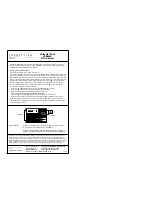
VHF Transceiver Manual
SM05 Rev 4.00
Nov 26, 2003
Page 1-2
ENG-FORM: 800-0107.DOT
CONFIDENTIAL AND PROPRIETARY TO NORTHERN AIRBORNE TECHNOLOGY LTD.
2.3.2
Cautions
All audio installations can be severely degraded by incorrect wiring and shielding, and
may result in much higher cross-talk, hum, and ground-loop interference. This should
be considered when audio wiring to and from the radio installation is performed.
2.3.3
Cabling
and
Wiring
For shielded wire applications use Tefzel M27500 or Raychem spec 44 (81044)
shielded wire with Raychem D140 or equivalent solder sleeves (for shielded
terminations) to make the most compact and easy to terminate interconnect. Tailor the
examples of installation diagrams in Section 2.4 for your own requirements.
Allow 3 inches from the end of the wire to the shield termination to allow the hood to be
easily installed. Note the hood is a "clamshell" type, and is installed
after
the wiring is
complete.
All channeling wiring should be 22 ga., except power and ground connections, which
must be 20 ga. or larger, as indicated on the installation drawings. Ensure that the
ground connection is clean, and well secured. Power to this system must be supplied
from a separate breaker or fuse, and not bundled to any other source to prevent
inadvertent system failure. A 3A slow-blow fuse or breaker is suggested for all models
except the NT030B, which should use a 5A, slow-blow fuse or breaker. (28 VDC
Source).
Coax cable should be RG-58C/U or similar mil-grade full coverage coax cable. At UHF
frequencies, use of double shielded RG-223/U, or large diameter RG-213/U may be
desired to reduce cable loss. Teflon dielectric cable is encouraged above VHF
frequencies, or where cable runs exceed 8 feet. Note that at UHF frequencies, cable
losses with even short runs may cut the ERP to less than 50% of spec.
To prevent RF interference between similar systems, it is recommended that VHF
COMM and VHF FM coax runs be widely separated, or be made using triaxial cable,
with the outer shield bonded to the airframe at one end only (transceiver end). In
communication intensive application, BAD CABLE ROUTING AND SHIELDING MAY
DRASTICALLY COMPROMISE OVER-ALL SYSTEM PERFORMANCE. SYMPTOMS
WILL BE SPURIOUS SQUELCH OPENING, RFI AND GARBLED RECEPTION.
RF cables must be neatly terminated (solder or crimp), and tested FOR SHORTS (NOT
WHILE CONNECTED TO THE RADIO!!) PRIOR TO SYSTEM CHECK-OUT. Avoid
sharp bends in the coax cables (min. 3" radius) to prevent severe reflections, especially
at UHF frequencies.
Содержание NT030
Страница 2: ......
Страница 4: ......
Страница 6: ......
Страница 20: ......
Страница 21: ...Confidential and Proprietary to NAT ...
Страница 22: ......
Страница 23: ......
Страница 24: ......
Страница 25: ......
Страница 26: ......
Страница 27: ...Confidential and Proprietary to NAT ...
Страница 28: ......
Страница 29: ...Confidential and Proprietary to NAT ...
Страница 30: ......
Страница 31: ...Confidential and Proprietary to NAT ...
Страница 32: ......
Страница 33: ...Confidential and Proprietary to NAT ...
Страница 34: ......
Страница 35: ...Confidential and Proprietary to NAT ...
Страница 36: ......
Страница 37: ...Confidential and Proprietary to NAT ...
Страница 38: ......
Страница 39: ...Confidential and Proprietary to NAT ...
Страница 40: ......
Страница 41: ...Confidential and Proprietary to NAT ...
Страница 42: ......
Страница 43: ...Confidential and Proprietary to NAT ...
Страница 44: ......
Страница 45: ...Confidential and Proprietary to NAT ...
Страница 46: ......
Страница 47: ...Confidential and Proprietary to NAT ...
Страница 48: ......
Страница 49: ...Confidential and Proprietary to NAT ...
Страница 50: ......
Страница 51: ...Confidential and Proprietary to NAT ...
Страница 52: ......
Страница 53: ...Confidential and Proprietary to NAT ...
Страница 54: ......
Страница 56: ......













































